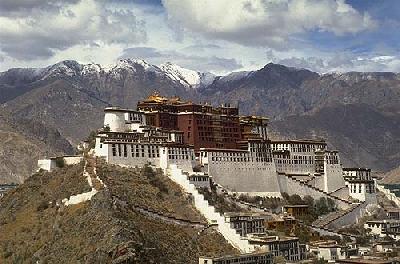| Art Q&A > Architecture |
|
|
Lhasa's Potala Palace
The Potala Palace, built on the Potala Hill (Red Hill), is an extremely magnificent castle, the only example in ancient China and a masterpiece rare even in world architectural history. In outward appearance, the 13-storey building is about 119 meters high, and covers an area of 100,000 square meters. Work to construct the Potala Palace began in 7th century of the Tang Dynasty (618-907) in honor of the Tang Princess Wenchen who was sent to marry Zhanpu King of Tufen Kingdom in Tibet, but was later destroyed in war. The present Potala Palace was rebuilt in the 2nd year (1645) of the rule of Qing Emperor Shizu, around the time when the fifth Dalai Lama went to Beijing to have an audience with him. It took 50 years to complete.
The outer walls of the central part of the Potala Palace are painted red, earning it the name of the Red Palace. Inside is the stupa hall containing stupa for the Dalai Lamas of all ages, as well as Buddhist halls. The east and west of the Red Palace are linked to the east and west White Palaces. The east White Palace holds the living area of the Dalai Lamas, while the west White Palace serves as monks' living rooms. Extending forward from the lower part of the Red Palace is a white terrace linking the east and west White Palaces, inside which are various warehouses.
Two rows of blank windows are added to the stone walls in the lower part, under which there is a 20-meter-high wall surface that exaggerates the height of the structure. On the dark brown wall belt there are many gilded copper plates. The chin-chuang, golden treasure bottles, and golden lotus on top of the wall extend into the sky and, together with the gilded roof, glow with charming radiance under the foil of the blue sky, white clouds and snow-clad mountain. From the bottom up, the way of treatment moves from coarse to fine, from simple to complex, from solid to charming and from monotonous to rich; the color goes from plain to colorful. Together, this naturally diverts people's sight line to the heights, making the structure loftier and more imposing.
The majestic, brilliant, magnificent and uninhibited Potala Palace has a strong artistic appeal and is an architectural art treasure that can be shown off to the world. |
||||||
All rights reserved. Reproduction of text for non-commercial purposes is permitted provided that both the source and author are acknowledged and a notifying email is sent to us. |
||||||
 |

